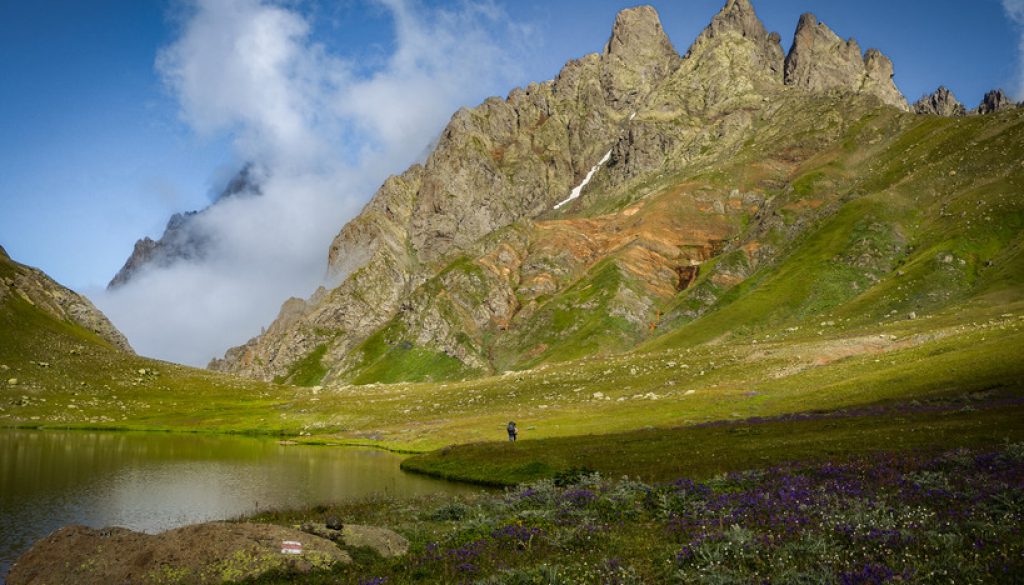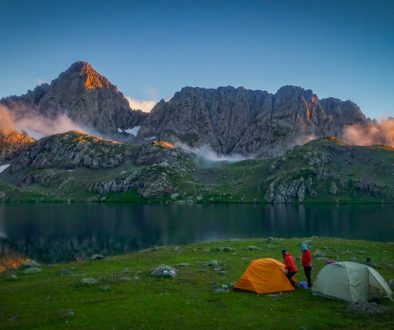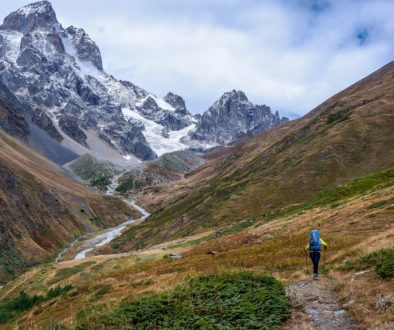#BlazetheTCT Day 15: Tobavarchkhili Lakes to Anaklia
Hello TCT hikers– and welcome to the last day of #BlazeTheTCT!
Today we’re hiking from the jagged mountains of the Egrisi range down to the lowlands of the Samegrelo swamps– all the way to the Black Sea.

Once you descend from the mountains, most hikers don’t expect much from this section. It’s flat walking through village roads all the way to the sea. But this section has a way of surprising you– through the warm people you meet, the striking traditional Megrelian wooden houses dotting the roadsides, the modern glass buildings rising out of the swamp near the coast.
So we’ll make our way slowly through the lowlands. And along the way, we’ll experience a lot of one of the TCT’s defining characteristics: generosity.
The generosity of a family waving you in to sit at their kitchen table. The generosity of a truck driver who, unprompted, hands you an ice cream cone on a long stretch of road. The generosity of hundreds of people who have shared their time and skills with us– from showing us the paths through their mountains, to lending their hands to build trails with us, to the strong community of TCT supporters like you that have made this whole project possible.
Thank you so much for joining us on this journey. We hope it inspires you to become part of the community making the TCT a reality– and to get out there and hike the trail yourself.
Now let’s make it to the Black Sea!
Happy trails,
Meagan

Watch the sunrise at Tobavarchkhili Lake
You wake up early to catch the stillness of the lake before the wind picks up. It’s calm this morning, and the lake is glassy, reflecting the craggy peaks around it.
The quietness around you is almost ringing, broken only by an insect’s chirp or a bird’s call as the world slowly wakes up. You light your camp stove and sip a cup of hot instant coffee, trying to absorb the peacefulness into your bones.

But there’s a big day ahead of you. So with a bit of reluctance, you peel off your warm layers from the night, climb back into your smelly hiking clothes, pack your tent, and smile back at the panorama that has been such a spot of peace for the past day.
You haven’t had cell service in a few days, and as you head back onto the trail, you’re glad for it. There will be plenty of time to upload your photos and reply to messages. But not yet.

Hiking out from the Tobavarchkhili Lakes.
Descend on old trails through the cliffs
As you leave the lakes behind, you follow a historical trail that’s much less popular than the typical approach to these lakes– but has stunning scenery to spare.
You crest the pass and the mountains fall sharply away. You descend on an old shepherding path that seems carved into the cliffsides at times, winding your way along the sides of a ravine. The fog rolls in thick, and you’re almost grateful that you can’t see the drops to the valley far below.

Above you, waterfalls cascade from the cliffs, and as the clouds swirl around you, you can almost feel the landscape moving bit by bit on a microscopic scale, slowly being carved out by the forces of water and seismic activity.


Eventually you reach the bottom of the steep valley– the site of an almost impossibly remote shepherds’ camp, whose friendly inhabitants are known to invite in hikers for homemade cheese.
Climb the rugged Okare Pass
But your day isn’t done: You’re climbing the rugged, unmarked Okare Pass.
This lesser-known gem is one of the region’s most dramatic gateways to the big mountains, climbing over steep rock faces and following old shepherding paths.
It’s a true backcountry experience– but your trail legs are strong from your journey through Armenia and Georgia, and you can’t resist the pull of one last big challenge.

Climbing to Okare Pass.
The pass is a small notch in a seemingly impassible wall of rocks– and the narrow trail leading to it is almost imperceptible until you’re right on top of it.
With a big effort, you pull yourself up the final steps to the pass– greeted by a remarkably well-cut path winding down along the steep slopes.
As the clouds continue to shift around you, you make your way to a gentle grassy patch and pitch your tent, settling in for your last night in the big mountains before you descend to the lowlands.

Late afternoon light below Okare Pass.
Descend to the lush forest
In the morning, you make your way through open fields and grassy shepherd tracks as you slowly descend below the tree canopy. You’re back in the land of rhododendrons and mud, stream crossings and small waterfalls.
But luckily, you don’t have to carve your own way through these rhododendrons like you did in Racha– there’s a small but distinct trail that you follow as it gradually leads you deeper into the green hills.


Enter the rolling lowlands of Samegrelo
Your long descent eventually brings you to the small hamlet of Skuri. But if you were expecting civilization, this isn’t exactly it: just a handful of houses at the end of a long dirt road.
It’s a long walk out as you follow the road, slowly making your way towards the bigger town of Tsalenjikha, where you can finally have a shower and eat some fresh food.
As you walk out of Skuri’s narrow valley, the rolling hills suddenly open up before you, with views all around– and buildings all around.
You’ve finally reached the more populated parts of the trail, where you’ll be weaving between small settlements for the next 70 kilometers as you make your way to the Black Sea.

The local traffic gives you a warm welcome.
It might be a shock to be out of the solitude of the mountains, but civilization also means one important thing: the prevalence of small roadside shops along your path. And that means that your ice cream consumption while hiking suddenly skyrockets.
Learn some Mingrelian phrases
As you begin to encounter more people, keep your ears tuned for new phrases: You’re likely to hear just as much Mingrelian as Georgian. Mingrelian is an indigenous Kartvelian language from western Georgia, primarily spoken in Samegrelo and Abkhazia. Just like the Svan language to the north, it is mostly unintelligible to native Georgian speakers.
When you make some new friends along the way, ask them to teach you some Mingrelian phrases– you’ll no doubt at least get a good laugh for your attempts.
Explore the quirks of Samegrelo’s lowlands
Many hikers expect this flat section to be boring– but it’s full of hidden gems.
You sleep on the grounds of an abandoned Soviet resort. You duck into chapels to find colorful frescoes. You camp on quiet riverbanks. You soak your tired feet in the natural hot springs in the village of Urta.

Soviet resort along the way. Photo by hiker Tom Runge.

The natural hot springs in the village of Urta. Photo by hiker Jeff Ballard.
And as you get closer to the coast, keep an eye out for the distinctive wooden oda houses, built on stilts to withstand the region’s frequent floods.

A wooden oda house in Samegrelo.
Make the time for unexpected hospitality
And now that you’re walking on roads and through villages, suddenly you’re an object of curiosity: hikers with big backpacks aren’t exactly common in these agricultural areas.
So leave some flexibility here to accept invitations as they come up, and to stop and chat. If you’ll let it, this cultural experience just might end up being a highlight of the whole TCT.
Several hikers have told us that they intended to speed through this section, doing big miles on the flatlands… only to end up with a backpack weighed down with fruit, nuts, and other local produce, fresh from the gardens.
Maybe, like us, you meet Beso and his daughter-in-law Maiko in the small village of Urta, who invited us in for fresh strawberries and homemade pickles while we were scouting routes in the region and told us about other paths in the region.

Maiko (right), welcoming us in for snacks and great conversation.
Or maybe you have this experience, like two hikers last year: You’re walking along a hot, exposed stretch of road, when a truck rumbles up behind you– and then pulls over right in front of you. As you pass, the driver reaches out of the window, wordlessly extending two ice cream cones. He gives you a big smile and a thumbs up– and drives off, leaving you with your ice cream and your surprised delight.
Without a doubt, you’ll have your own experiences that make this section special. The legendary Georgian hospitality often shows up at unexpected moments.
But the generosity you encounter here will make your steps lighter– and, as the best travel experiences do, it will leave you thinking about how you can pay it forward when you get home.
Celebrate at the Black Sea
And at last… with your heavy backpack laden with fresh fruit, fueled by ice cream and chance encounters, you arrive in the seaside town of Anaklia.
It’s a small town, quietly bustling with summer visitors and a visually baffling mix of old-style houses and modern glass architecture.


Anaklia is a crossroads in several senses. It’s just a few kilometers from the de-facto border of Abkhazia. And it shows some of the changes many Georgia has been through in its buildings: the nearby crumbling Soviet resorts, the glass structures and massive modern sculptures built during Georgian ex-president Saakishvili’s early 2010s campaign to build a futuristic port city in the region, the new seaside hotels built in the hopes of attracting tourists– all with the backdrop of dirt roads and traditional houses just a few streets away, and the dense wetlands of Kolkheti National Park just a few kilometers to the south. And this, too: a lovely new campsite by the river, hosting hikers and local scouting groups, run by former TCT volunteer Giorgi Tchezhia.
In that sense, Anaklia feels like a fitting place to reflect on all the different experiences you’ve had during your hike, as you make your way to the water.
You think about the deep traditions you’ve encountered and the currents of history that run deep through the places you’ve walked through– the ancient monasteries, the nomadic shepherd camps, the modern towns built on Bronze-Age settlements, the small villages defined by geographic isolation.
And you think about the ways that modern technology and tourism are changing life in remote parts of the Caucasus– homogenizing some things, sure, but also creating opportunities for people like Nvard in Meghri, Sona and Vahagyn in Bekh, Mher in Sisian, Garnik in Artavan, Samvel and Hasmik in Gandzani, Rafael in Akhalkalaki, Elizabeth in Adishi, and Valeri and Maro in Kichkhuldashi to maintain their traditions and proudly share their culture.




For your last steps, you cross the pedestrian bridge over the mighty Enguri River– a river you’ve traced through the mountains of Svaneti, now emptying out into the Black Sea.

At the arch of the bridge, you look to the east and see the snow-capped peaks of the Greater Caucasus glowing pink in the evening– all those mountains that the trail carried you through, the peaks that strengthened your legs and the hospitality that cracked open your heart just a little bit more.
And you look to the west and watch the waves softly crashing on the rocky black sand. After 1500 kilometers, you’ve finally made it to the Black Sea.
And now: Enough philosophizing. You’ve walked a long way to get here. You walk the last steps down to the shore and take off your disintegrating hiking shoes.
Time to go for a swim.

Sunset swim in the Black Sea. Photo by hiker Harry Kuril.
And that’s the end of our 1500-kilometer journey along the TCT through Armenia and Georgia.
From all of us at the TCT: Thank you for coming on this journey with us. We hope you’ve enjoyed coming with us on the trail and meeting some of the people and places that make the trail so special.
It was a bit of a marathon effort, we’ll admit– but we had a lot of fun digging through the TCT archives and sharing some stories of the trail experience with you.
We hope you’ve learned something interesting about the region, that you have some new places on your list to visit, and that one day you’ll come hike the trail and experience it for yourself.
And if our stories over the past 2 weeks moved you in some way, we’d love to hear from you: Let us know what you thought of this experiment!
In the meantime, we need all the help we can get to continue developing the trail. It’s been a massive community effort over the last 8 years. As you’ve seen over the past 2 weeks, it’s come a very long way from the crazy idea it once was. And there is still so much we aim to do over the next decade to continue making the TCT an incredible experience that benefits hikers, communities, and nature alike.
The next step in that process is installing clear, easy-to-follow trail signage and blazes along new sections of the trail. That’s a big piece of transforming a “route” into a real trail– it makes a huge difference for safety and accessibility, which in turn makes a big difference for the people you met building businesses along the TCT.
And today is the last day of our fundraising campaign to do just that: We’re blazing the TCT. If you’ve enjoyed our virtual hike, we really hope you’ll join us to make these efforts possible.
So if you’ve been meaning to donate, today’s the day. Let’s make some waves on the last day of our campaign, as we celebrate the end of our journey– all the way from southern Armenia to the Black Sea!
Thank you all so much for your generosity, near and far– and thanks for joining us.
We can’t wait to see you on the newly-blazed TCT!
Happy trails,
Meagan & the TCT team

The TCT Team from Armenia, Georgia, and Azerbaijan together in Tbilisi. We’ll look forward to meeting you on the trail!





